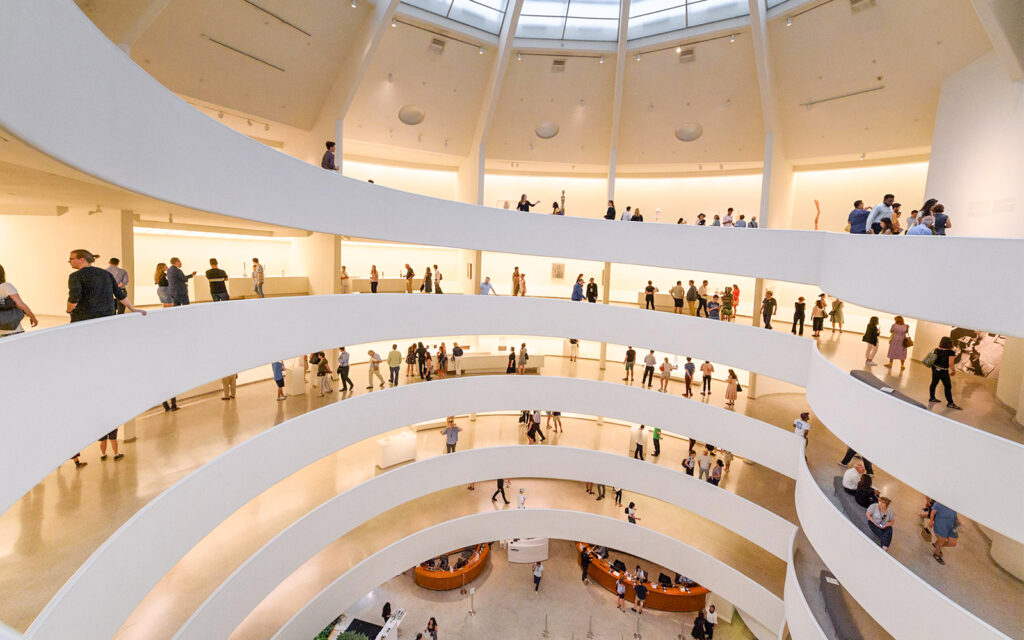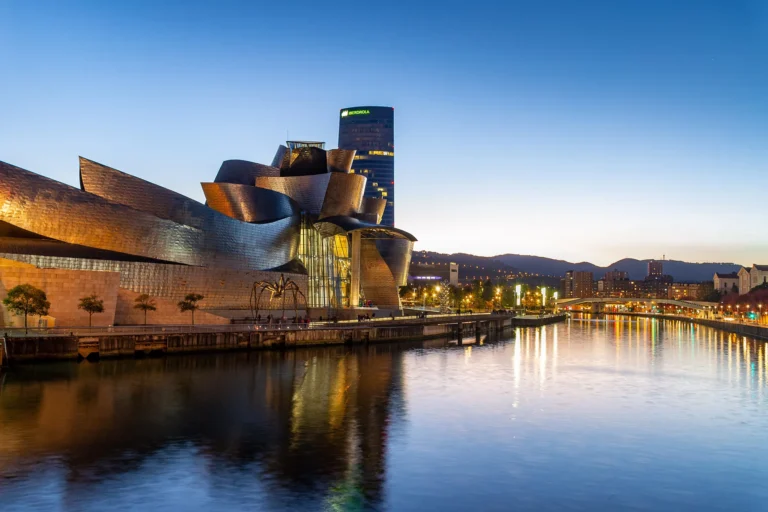
The Guggenheim Museum in Bilbao, Spain, is one of the most remarkable and innovative architectural structures in the world. Opened in 1997, it has become a symbol of both the city and modern architecture itself. Designed by renowned architect Frank Gehry, the museum is a striking example of deconstructivism, a style characterized by fragmented shapes and forms. Its unique and bold design, along with its significant cultural impact, has transformed Bilbao from an industrial city into a vibrant cultural destination, drawing millions of visitors each year. The Guggenheim Museum is not just a place to house art; it has become an integral part of the city’s identity.
۱. اطلاعات کلی
– Name: Guggenheim Museum Bilbao
– Location: Bilbao, Basque Country, Spain
– Architect: Frank Gehry
– Opening Date: October 18, 1997
– Architectural Style: Deconstructivism
– Building Area: 24,000 square meters
– Collection Type: Modern and Contemporary Art
– Function: Museum for contemporary art, cultural hub
– Notable Feature: Organic, flowing shapes and metallic façade
2. History of the Guggenheim Museum Bilbao
The idea for the Guggenheim Museum in Bilbao was conceived as part of a broader effort to revitalize the city, which had been heavily industrialized. Bilbao, once a bustling port and steel-producing hub, had seen its economy decline as heavy industry faded. The city sought to transform itself into a center of culture and tourism, and the Guggenheim Museum played a central role in that vision.
The museum was part of the Solomon R. Guggenheim Foundation, which already had museums in New York, Venice, and Berlin. In 1991, after an international competition, Frank Gehry’s design was chosen. The project was ambitious, not only in terms of its artistic vision but also its complexity in construction. Gehry’s unconventional design, featuring flowing curves and irregular shapes, required cutting-edge technology and materials to bring it to life.
Construction began in 1993, and despite significant challenges, the museum was completed in 1997, rapidly becoming one of the world’s most visited and celebrated architectural landmarks.
3. Architectural Features of the Guggenheim Museum Bilbao
The Guggenheim Museum’s architecture is a brilliant example of deconstructivism, an architectural style that emphasizes non-linear, fragmented, and disordered shapes. Here are some key features of its design:
- Curved and Fluid Shapes: The museum’s design features a series of sweeping curves and organic forms that seem to grow out of the landscape. The fluidity of the building gives it a sense of movement, making it appear as though the structure is constantly evolving.
Titanium Facade: One of the most distinctive features of the Guggenheim Museum is its titanium-clad exterior, which gives the building its shiny, metallic appearance. The titanium panels reflect light, changing the building’s color throughout the day and in different weather conditions. This makes the museum a dynamic, ever-changing visual experience.
Complex Geometry: The building’s design defies traditional architectural norms. It features non-rectilinear forms and sharp angles that give the structure an almost sculptural quality. The museum is a composition of interconnected volumes, creating an asymmetrical but harmonious whole.
- Glass Walls and Light: The use of glass is prominent in the Guggenheim Museum, allowing natural light to flood the interior. The glass facades offer dramatic views of the surrounding environment, including the Nervión River and the city of Bilbao.
- Atrium and Sculpture Garden: At the heart of the museum is the grand atrium, a soaring space that allows visitors to experience the scale and fluidity of the architecture. The museum also features an outdoor sculpture garden, adding a third dimension to the art it houses.
4. Cultural and Economic Impact
The Guggenheim Museum Bilbao has had a profound cultural and economic impact on the city and beyond. Some of the key contributions include:
- Cultural Renaissance: The museum has been a driving force in the cultural revitalization of Bilbao, transforming it from a post-industrial city into a thriving center for contemporary art. The museum hosts a wide variety of exhibitions, including major retrospectives of modern artists and installations by innovative contemporary creators.
- Tourism Boost: Since its opening, the Guggenheim has attracted millions of visitors, both local and international. It is one of Spain’s most visited tourist attractions, contributing significantly to the local economy by bringing in revenue through tourism and increasing the demand for services such as hotels, restaurants, and transportation.
- Global Art Platform: The museum is a leading venue for contemporary art, regularly showcasing works by world-renowned artists. Its influence extends globally, as it has become a key player in the international art scene. The museum’s exhibitions have brought attention to both established artists and new, emerging talents.
- Urban Regeneration: The creation of the Guggenheim Museum has been credited with kickstarting the Bilbao Effect, a term used to describe how a striking cultural building can lead to urban regeneration. The museum has spurred the development of new infrastructure, including hotels, restaurants, and public spaces, thus boosting the city’s profile on the global stage.
5. Notable Artworks and Exhibitions
The Guggenheim Museum Bilbao is home to an extensive collection of contemporary art, featuring works from artists such as:
- Richard Serra: The museum’s collection includes the monumental sculptures of Richard Serra, such as the iconic “The Matter of Time” installation, a series of massive steel sculptures that visitors can walk through.
- Jeff Koons: Known for his vibrant and playful work, Jeff Koons has exhibited several large-scale pieces at the museum, including his famous “Puppy” sculpture, a giant flower-covered dog that stands outside the museum.
Louise Bourgeois: The museum has also showcased installations by Louise Bourgeois, including her well-known spider sculptures, which evoke themes of femininity and memory.
Temporary Exhibitions: In addition to its permanent collection, the Guggenheim hosts rotating exhibitions from artists around the world, creating a dynamic and ever-changing art experience for visitors.
Conclusion
The Guggenheim Museum Bilbao is much more than just a museum; it is an architectural masterpiece that has changed the landscape of contemporary art and urban development. Its unique design, by Frank Gehry, has made it one of the most iconic buildings in the world, and it stands as a testament to the power of architecture to transform cities and cultures.
Beyond its aesthetic appeal, the Guggenheim Museum has played a pivotal role in the cultural revitalization of Bilbao, turning the city into a global center for contemporary art and tourism. It has demonstrated the profound impact that a well-designed cultural institution can have on a city’s economy and reputation.
The Guggenheim Museum Bilbao is a symbol of innovation, creativity, and the enduring connection between architecture and art. It continues to inspire visitors and architects alike, proving that bold and visionary design can have far-reaching effects on both the local community and the world at large.


No comments yet.